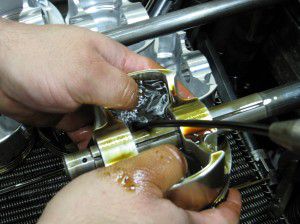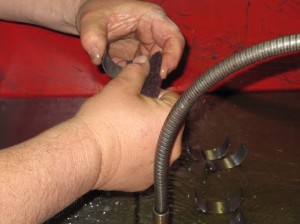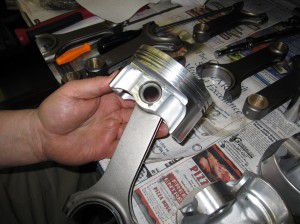Learn to Build a 427 Ford V-8 Engine (Part 1)
Text and Photos by Steve Stilwell
Article
I’ve been a GM man most of my life, but I checked the pulse of the industry and knew that while it might be more affordable to drop a small-block Chevy crate motor within the confines of classic Ford’s huge engine bay, that move would be unpopular with today’s custom car guys, especially the very opinionated muscle car crowd. When it comes to engine selection, one of the most influential men I’ve come across is Tom Lieb of Scat Enterprises. Scat manufactures racing performance products, pro car seats and high-performance crankshafts, rods and complete engine rotating assemblies.

Race Tech pistons were ordered to fit the 4.125-inch cylinder bore, however, Shaver prefers to personally hone the wrist pins in-house. Ron finished the bore with a .005-inch clearance.

The next order of business is to set the piston wrist pin and rod clearance. The target is a much tighter clearance than the .005-inch measurement achieved on the piston clearance.
Lieb said, “Guys are tired of seeing classic Fords powered by a 350 Chevy. Today’s car builders want things that are different. Back when I grew up, different meant having a ‘40 Ford coupe with an Olds engine and a Hydro [transmission]. Nailhead Buicks were the rage. Going through the different cars, you would see that every other car would have a different engine. That was the day, and that theory is returning.”
Lieb commented on crate motors in general. “When it comes to dropping in a crate engine versus a custom engine, the idea is to have something different. Once you have seen one Chevy V-8-powered roadster, you have seen them all. On the other hand, a car with a trick Ford engine has a little more notoriety because it is out of the mainstream.

Shaver opted to stamp the numbers into these rods (so that both halves will always match) Ford style, opposite the bearing tang on these Scat 6-inch racing rods.

I have assembled engines before, but I went to school at Shaver's by seeing first-hand some very unique procedures. My mouth dropped open when Ron buffed all the sharp edges off the camshaft, but it makes sense to eliminate any possible metal shards from coming loose and finding their way to a bearing!
“With a crate engine, you lift the hood and it is like finding a disappointing V-6. A four-barrel-equipped 350 with chrome valve covers just kills the car. It’s just not so special.”
Lieb continued, “The car has the same engine as 49 other peoples’ cars do, and if you swap out the valve covers and such, you might as well throw [the cost of] those parts away.” To end up with a unique engine, Lieb suggests that you “start with a seasoned or new block, then order a rotating assembly that is ready to install. Work to build the engine from that point.”

No surprise that the following step was to cleanse the buffed cam in the solvent tank. This is a COMP Mutha Thumper roller cam featuring .564/.571 lift. It's a pretty radical bump stick.

The key component of having the Dart 351W block end up with a 427-ci displacement was the addition of a 4-inch Scat stroker crankshaft. This engine is externally balanced, so bob weights determined that 1-ounce of weight had to be added in this area of the crankshaft again, an in-house procedure.
Back to the 427 build, this engine is based on the latest offering from Dart Machinery, a cast iron 351 Windsor Sportsman block with Pro One Dart heads. This combination looks like it is going 100 mph standing still, and is the answer to putting a Ford into a Ford.

Ron could not overemphasize the importance of ensuring every component of this engine has to be cleaned, recleaned and then wiped clean with solvent to ensure any contamination and assembly lube is removed, especially in the oil galleys. The crank was made spotless with passages scrubbed with a bottle brush, as shown.

Bearings, such as these from Mahle, are coated to protect them during shipping and to extend shelf life (according to Ron). Shaver removes this coating with a Scotch Brite pad to ensure a perfect tolerance for an exacting engine oil film.
Just down the street from Scat in Redondo Beach, California, is Shaver Specialties located in Torrance. Ron Shaver (who happens to build all of Tony Stewart’s championship-winning Sprint car motors) was aware of this new Dart block. Once he was informed about Scat Enterprises’ interest in supplying a stroker crank and rotating assembly with the idea being to build a 410–cid small-block Ford, Shaver commented, “That new Dart Windsor block has a 9.5-inch deck height and it would be a piece of cake to make it into a 427.” So they ordered custom rods and a 4-inch stroker crank. When the Dart block arrived, it had been bored to the appropriate 4.125 inches. Combine a 4-inch stroke with a 4.125 bore, and presto, you have 427 ci!

Crankshaft-to-block bearings are then installed into the Dart block in preparation for checking the clearances between the block and crankshaft. Note the coatings have been removed from the bearings.

Dart’s Sportsman 351W block is fit with huge four-bolt main caps to ensure against any crankshaft movement or flex. Center bearing caps are fit with Mahle crank bearings.
This custom 427 engine has components from Dart, Scat, Moroso, Pure Power, AAEQ, ARP, COMP Cams, Mahle, Cloyes, Melling, Race Tec, Mr. Gasket, Accell, Ferrea, Vintage Air and the services of expert engine builder Ron Shaver. In today’s muscle car world, the car owner likes to know his engine components and can rattle off the name of every component used to assemble this engine. It will be a pleasant surprise to everyone each time the hood is opened to expose this eye-popping, custom-built V-8. Especially when they realize they are looking at a fuel-injected, 427-ci Dart/Ford engine with ground-shaking power. In our next installment, we finish putting it together and make a dyno run!

- Both the crankshaft journals and bearings are checked for clearance using a dial indicator. Tolerances are held to within thousandths of an inch. “Crate engines are built in batches, cookie cutter style, and when you build in volume, not everything gets measured,” stated Shaver.

Setting the crankshaft end play takes the master’s touch. Shaver partially torques the crankshaft bearing caps, then watches with a dial indicator as he wedges a flat blade screwdriver between a crank weight and block cap. Once he creates .006-inch of play, all crankshaft bolts are torqued to specs.

A special piston-like tool is used to position each ring into a finished, properly sized cylinder. Top rings are gapped at .018 or .016 on the second ring and the oil rings are set to 20 pounds of drag with a .025-.030 clearance.

Race Tech pistons are attached to the Scat 6-inch H-beam rods using C-clips. The wrist pin is lubed and all that measuring and honing is evident by the tight slip fit. Rod bearings were honed to .0024-.0027 clearances.

Pistons are fit with gapped rings and installed into the block making sure to use a large amount of engine assembly lube. Machine work on the Race Tec pistons is nothing short of a thing of beauty. Since we’re going to use pump gas, there is no dome.

An engine builder never wants to assume that the pistons will not hit the heads. Shaver checks each piston’s deck height with the average being about .003 inch. Plenty!

The Cloyes timing chain set features a number of options, including the ability to customize cam timing through crank key selection or alter cam timing via this fuel pump drive. We will use the latter for cam timing, but not for fuel pump purposes.

Every component of an engine has a small amount of discrepancy caused by the tolerances of manufacturing. The only true way to ensure 100 percent accuracy of the timing of the cam, valves, pistons, crankshaft, etc. is to check the engine’s rotation using a dial indicator. Shaver went one step farther and installed the cam to 4 degrees BTDC. This step enhances engine torque. A step not taken with a crate engine!

Shaver demonstrated a real trick that has to be used on those high compression race engines his shop is known for supplying to Sprint car race teams. The compression ratio of the engine is determined by the amount of fluid displaced by the stroke of the piston. The test proved we had achieved the desired 9.2:1 ratio for pump gas operation.


